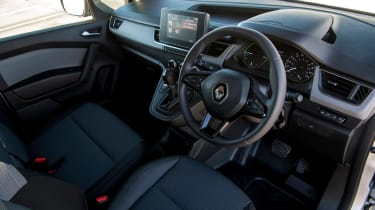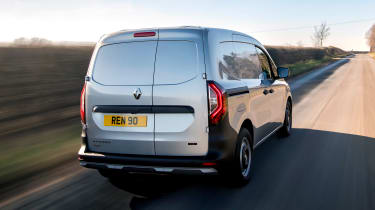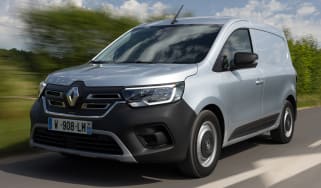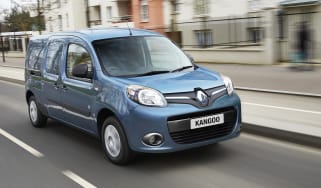Renault Kangoo E-Tech review
Renault’s new compact electric van gets more technology, range and cargo space than before, jumping straight to the front of the pack
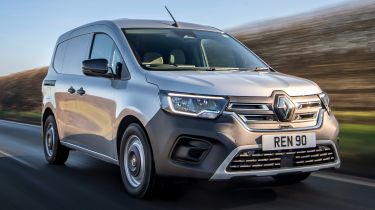
Pros
- 186-mile range
- Cargo space
- Comfortable and refined
Cons
- 80kW rapid charging
- Regenerative braking
- No load-through bulkhead
| Van type | Range | Wallbox charge time | Rapid charge time |
|---|---|---|---|
| Electric | 186 miles | 7hrs 10mins (0-100%, 7.4kW) | 31mins (15-80%, 80kW) |
The Renault Kangoo has been a key player in the small van market since its introduction in 1997, and was an early adopter of electric power. The fully-electric Kangoo Z.E. burst onto the scene in 2011, offered in a range of bodystyles and with similar technology to the Renault ZOE city car. But, after 10 years on sale and being laid to rest back in 2021, the new Renault Kangoo E-Tech is here to pick up where it left off.
It’s also the first of a trio of new small electric vans based on the same underpinnings, with its sister models the Nissan Townstar and Mercedes eCitan both due to arrive later this year. Until then, the Kangoo E-Tech’s closest rivals are the joint winners of our 2023 Best Small Electric Van award: the Citroen e-Berlingo, Peugeot e-Partner, Vauxhall Combo Electric. Fiat E-Doblo and Toyota Proace City Electric which all use the Stellantis Group’s tried and tested EV running gear.
Another option for some is the Volkswagen ID. Buzz Cargo, which we named the Best Medium Electric Van for 2023. It’s a larger, more expensive and style-focused van than the Kangoo E-Tech, and it offers significantly more range, but the cargo space in both is very similar.
The Microbus-inspired ID. Buzz Cargo might be the most photogenic van we’ve ever seen, but the new Kangoo is certainly more handsome than its predecessor. Every model comes with black plastic bumpers front and rear to help reduce repair cost, and sitting inside the Kangoo you’re greeted with a similar array of grey and black plastics, and hard-wearing fabric seats that have been built to last.
That said, the cabin also borrows its switchgear, steering wheel and climate control dials from the current Clio supermini. No bad thing; the latest Clio is more upmarket than previous generations, so it provides the Kangoo with a smattering of slightly more premium touches – at least for a small van.
There’s no fully-digital driver’s display though, just analogue instruments including an energy flow gauge in place of a rev counter, paired with a 3.5-inch display for additional information. Higher-spec models also get an eight-inch touchscreen featuring Apple CarPlay and Android Auto smartphone connectivity.
There’s a choice of a standard or long-wheelbase models, with both Kangoos featuring twin doors at the rear that split 60:40 and open up to 180 degrees. The standard model comes with a single nearside sliding side door and offers a total cargo volume of 3.3 cubic metres, while the LWB version has a sliding door on either side and has a 4.2 cubic-metre cargo capacity. A steel bulkhead separates the cargo area from the cabin – there is no through-loading bulkhead available like in the e-Berlingo, which is a shame because they’re handy if you regularly transport longer items.
The Kangoo E-Tech has a maximum payload of 608kg in standard wheelbase form, or 764kg for the long-wheelbase version. That’s over 200kg less than the petrol or diesel Kangoo, mainly due to the E-Tech’s hefty battery pack.
This time around the electric Kangoo uses a 118bhp electric motor to drive to the front wheels, which produces a substantial 245Nm of torque, too. The motor is fed by a 44kWh battery – up from 33kWh in the old Kangoo Z.E. – which, according to Renault, can provide enough juice to cover 186 miles.
Fast charging is another new addition to the Kangoo E-Tech, however it’s only capable of reaching 80kW. In comparison, its rivals from Citroen and Fiat can hit 100kW, while the ID. Buzz Cargo can charge at up to 170kW. That means a 15-80% top-up in the Kangoo will take 31 minutes, which should equate to a little over 100 miles of range. You’ll need just over seven hours to fully recharge the Kangoo’s battery from a 7.4kW home wallbox.
Pull away, and Renault's familiar spaceship-style whirr warns pedestrians of the otherwise silent electric van’s presence, deactivating when you hit 20mph. Getting up to speed is no trouble with the amount of power and torque available from the electric motor. In fact, the front wheels can scrabble for grip if you stomp on the throttle.
Light steering makes it easy to place on the road and traverse tighter streets around town. Cruising on the motorway, the Kangoo E-Tech is quiet and refined, with minimal wind and tyre noise filtering into the cabin. The ride is also pretty good for a van, and you get a good view of the road ahead.
Select Drive and the Kangoo coasts normally, while switching to B mode on the large gear lever adjusts the strength of the regenerative braking. There are three stages available, but the default is Level 2. Level 3 isn't as strong as the recuperation systems we've experienced in the electric Kangoo’s closest rivals, nor does it offer one-pedal driving. Level 1 is barely any stronger than simply coasting.
There are two drive modes on offer, too: Normal and Eco. The latter limits power to 74bhp and the top speed to 68mph to help save battery energy. However switching into Eco doesn't result in a sudden increase in range on the instrument panel, so it's hard to gauge what impact this mode actually has in real-world driving. Unless you’re trying to squeeze every mile out of the battery, it’s probably best to leave the van in Normal mode to avoid using more energy getting up to speed with the restricted power available.
There are two trim levels to choose from – Start and Advance – both available in the two body lengths we mentioned. Standard kit includes heated seats, a heated windscreen and that 3.5-inch display for the instrument panel, plus a Type 2 charging cable, cruise control and a heat pump. This is something of a rarity in the electric van market, but helps to reduce energy consumption when you’re heating the cabin, in turn improving the Kangoo's range.
Stepping up to the Advance trim costs £1,800, but also adds an eight-inch central central touchscreen, Apple CarPlay and Android Auto connectivity, a Thatcham Category 1 alarm, 18-inch alloy wheels, wide-view mirrors and reversing sensors.
There’s plenty of extra kit on offer, too, such as traffic-sign recognition, blind spot warning and driver attention alert as part of the Advanced Driver Assist Packs. Parking Pack 1 adds 360-degree parking sensors and a rear camera, while Parking Pack 2 includes full parking sensors, hands-free parking and a display where the rear-view mirror would be, showing a live feed from a camera mounted at the back of the van – which we found to be a useful add-on.
After years of the Citroen e-Berlingo and its many Stellantis Group sibling’s dominating the small electric van market, a worthy foe has finally arrived in the shape of the Renault Kangoo E-Tech. It might be a little behind the times for charging speeds, and not fitting a through-load bulkhead is a missed opportunity. But in the areas that matter – range, cargo space, comfort, refinement and kit – the Kangoo E-Tech doesn’t disappoint.
